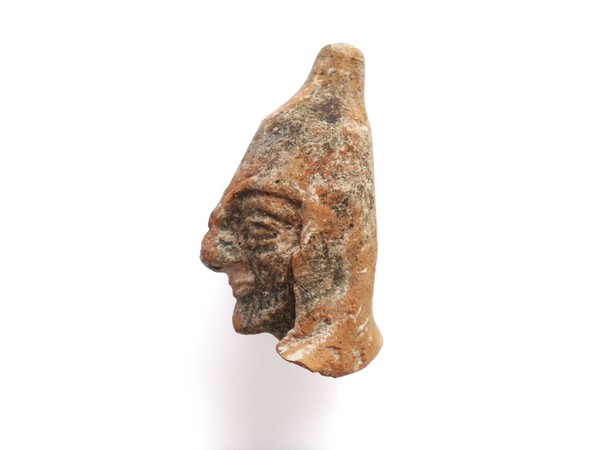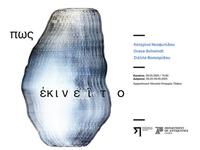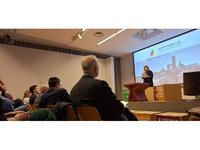Press Releases
28-08-2023 12:52
Excavation at the Sanctuary of Apollo at the locality of Frangissa, in the area of Pera Orinis
The Department of Antiquities, Deputy Ministry of Culture announces the completion of an archaeological excavation campaign in the area of Pera Orinis, in October 2022, with the aim of exploring the Sanctuary of Apollo at the locality of Frangissa. The work was carried out by the Goethe-Universität Frankfurt, under the directorship of Prof. Matthias Recke, generously supported by the Amricha Foundation Leipzig. Field Director is Philipp Kobusch (Kiel University).
Two years ago, a team of researchers from the German universities of Frankfurt and Kiel successfully located the sanctuary of Apollo at Frangissa near Pera Orinis, which had been known since 1885 but was considered lost. In 2021, an initial excavation campaign uncovered the remains of ancient masonry, although the interpretation of the complex construction history and its function within the sanctuary area had to remain open for the time being.
In 2022, this work was continued with the aim of not only re-exposing the areas of the 19th century excavations and documenting them according to modern standards, but also exploring the previously unexamined surroundings of this precinct.
Ancient sanctuaries were complex and multifaceted areas that provided not only facilities for ritual practices but also served many social, political, and economic functions. Through the exemplary investigation of the sanctuary of Frangissa, the current research project aims to explore these complex structures, which often evolved over several centuries, and gain important insights into the functioning of ancient sanctuaries.
The ongoing excavations allow for a closer examination of the building remains, that were uncovered in the previous year's campaign. It is an architectural enclosure of an open district measuring at least 12x17 metres. The walls consist of carefully placed stone sockets, reaching a height of up to 1.20 metres, and are largely intact up to the upper terminating edge (Fig. 1). These walls served as bases for mud-brick masonry, which is no longer preserved. Despite its fragility, parts of the carefully trimmed, flat rammed earth floor of the area have been partially preserved.
Based on the current state of knowledge, the construction of this complex can be dated to the Hellenistic period. However, after its construction, the district underwent successive remodeling and expansion. In a later phase, transverse walls were added, altering the interior of the courtyard. Additionally, parallel flat stone bases were erected alongside the outer walls, likely serving as supports for columns and carrying the roof of a hall that surrounded all sides. This may have provided protection from the weather for particularly valuable votive offerings. Towards the end of the excavation, a stepped structure consisting of meticulously hewn blocks was discovered in the immediate vicinity of the courtyard. Such large and high-quality blocks were previously unknown at Frangissa. Not only the precision of the dressing but also the imported material used makes this finding exceptional. Typically, all architectural structures in the sanctuary were made of local limestone. Therefore, this discovery represents a remarkable monument and its complete excavation in a later campaign will significantly expand our knowledge of the sanctuary's furnishings.
While the exact connection between the Hellenistic courtyard and the previous excavations, as well as the core area of the sanctuary, remains unclear at present, its sacred function in relation to the sanctuary has been impeccably proven by the rich finds, such as votive figures (Fig. 2). The core of the sanctuary, which also included an open courtyard with a roofed cult room, dates back to the Archaic period. The newly discovered structures provide evidence for a larger expansion phase of the Frangissa sanctuary during Hellenistic times, significantly increasing the built-up area and expanding the possible uses of the sanctuary. The Hellenistic sanctuary is more than twice as large as previously known.
Another significant find was the discovery of terracotta fragments, initially appearing inconspicuous but of great beauty. These fragments belong to a larger-than-life male terracotta figure, which, similar to the well-known Colossus of Tamassos in the Cyprus Museum (originating from the same sanctuary), was assembled from several individual parts. The robe of the figure was intricately decorated with incised ornaments. Similar fragments were previously found in 1885 and taken to the Cyprus Museum. The newly found fragments perfectly match these ancient fragments, confirming the identification of the sanctuary with the site excavated in 1885, which was previously based on various circumstantial evidence.
The planned continuation of the excavation in the upcoming year will further explore the function of the courtyard and its precise connection to the sanctuary core.
_____________
Figure 1: Part of the Hellenistic enclosure wall
Figure 2: Head of an archaic warrior statuette
(NG/SCH)
Relevant Press Releases

28-03-2025 18:12
European Statistics Competition, National Phase


26-03-2025 14:03
The National Struggle Museum will remain open on 1st April 2025






